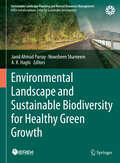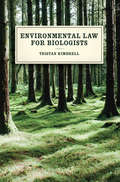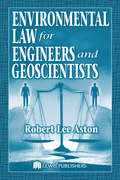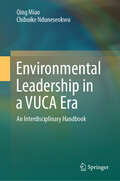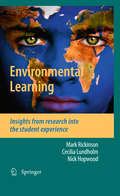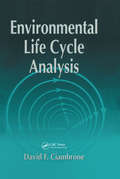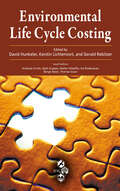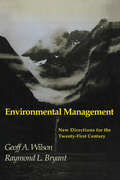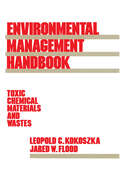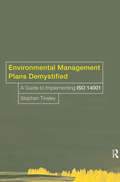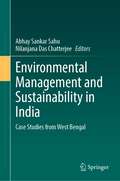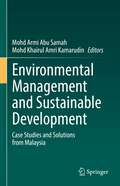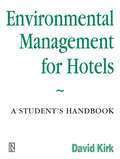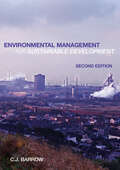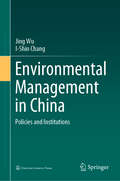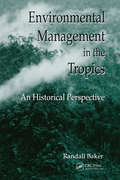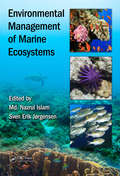- Table View
- List View
Environmental Landscape and Sustainable Biodiversity for Healthy Green Growth (Sustainable Landscape Planning and Natural Resources Management)
by Javid Ahmad Parray A. K. Haghi Nowsheen ShameemThis unique reference book represents sustainable development of UN for providing a proper life standard and mobility for people. The 17 sustainable development goals (SDGs) as set by the United Nations for 2030 are the most basic prerequisite for the growth and development of national health. This book also provides broad case studies to show the interconnection of sustainable development goals of healthy lifestyle that will have enormous impacts on proper environmental health standards. In this advanced reference book, the authors will invite experts from around the globe to help the readers to better understand the interconnection between the UN sustainable development goals and environmental sustainability for 2030. To achieve these goals, the authors have divided this reference book into four sections: The first section of this research-oriented book is devoted to reviewing the basic concepts of the healthy environmental sustainable development goals by considering the current world population of 7 billion. The plan is that the chapters selected in this section should provide the most important aspects needed in detail. In Section 2, to reach novel technology innovations for making changes in environment health policy, the requirements for making remarkable challenges along with the global economy are reviewed. Section 3 is used as a practical guide for postgraduate students interested in gaining their knowledge in the area of the environmental sustainability without a strong background in all 17 (SDGs) as set by the United Nations for 2030 and the different aspects of the sustainability for a healthier lifestyle. ϖ Section 4 addresses case studies to cover conceptual framework on how to better understand the sustainability goals and synergies among organic food, green energy, and clean water technologies. It also exchanges valuable experiments in this multidisciplinary field by renowned research scientists.
Environmental Law for Biologists
by Tristan KimbrellEnvironmental law has an unquestionable effect on the species, ecosystems, and landscapes that biologists study--and vice-versa, as the research of these biologists frequently informs policy. But because many scientists receive little or no legal training, we know relatively little about the precise ways that laws affect biological systems--and, consequently, about how best to improve these laws and better protect our natural resources. With Environmental Law for Biologists, ecologist and lawyer Tristan Kimbrell bridges this gap in legal knowledge. Complete with a concise introduction to environmental law and an appendix describing the most important federal and international statutes and treaties discussed, the book is divided into four broad parts: laws that focus on individual species, like invasive species policies, the Endangered Species Act, and international treaties such as CITES; laws that focus on land, from federal public lands to agricultural regulations and urban planning; laws that focus on water, such as the Clean Water Act; and laws that focus on air, such as the Clean Air Act and international measures meant to mitigate global climate change. Written for working biologists and students alike, this book will be a catalyst for both more effective policy and enhanced research, offering hope for the manifold frictions between science and the law.
Environmental Law for Engineers and Geoscientists
by Robert Lee AstonToday’s engineering and geoscience student needs to know more than how to design a new or remedial project or facility. Questions of law and ambiguities of terms often occur in contracts for mining, landfills, site reclamation, waste depositories, clean up sites, land leases, operating agreements, joint ventures, and other projects. Work place situations arise where environmental compliance methods are challenged by enforcement agencies. Although the statutes, rules, and regulations may seem to be worded clearly and specifically, there are often questions in application and sometimes varied interpretations. Environmental Law for Engineers and Geoscientists introduces simplified American jurisprudence focusing on the legal system, its courts, terms, phrases, administrative law, and regulation by the agencies that administer environmental law. The book comprehensively covers the “big five” environmental statutes: NEPA, CAA, CWA, CERCLA, and RCRA. With the basic law chapter as a foundation, the book covers the practical applications of environmental law for geo-engineers. It concludes with a chapter on the growing area of expert witnessing and admissible evidence in environmental litigation — an area of law where success or failure increasingly depends on the exacting preparation and presentation of expert scientific evidence. Written by a professional mining and geological engineer and a practicing attorney, Environmental Law for Engineers and Geoscientists prepares students for the numerous environmental regulatory encounters they can expect when dealing with various statutes, laws, regulations, and agency rules that govern, affect, and apply to environmental engineering projects. It provides a working knowledge of how to judge whether or not a project is in compliance with regulations, and how to ensure that it is.
Environmental Leadership Capacity Building in Higher Education: Experience and Lessons from Asian Program for Incubation of Environmental Leaders
by Takashi Mino Keisuke HanakiThe Graduate Program in Sustainability Science under the Department of Urban Engineering of The University of Tokyo has been running an environmental leadership education program at the graduate student level since 2007 called the Asian Program for Incubation of Environmental Leaders (APIEL). This book describes the University's experiences in establishing and organizing that program and provides some lessons learned for those who are considering starting environmental leadership education programs. APIEL's curriculum includes the classroom topic "Environmental Challenges and Leadership in Asia." As well, the APIEL program has field units to provide experience in problem solving, decision making, and participation, taking into consideration ecological, political, economic, social, aesthetic, and ethical aspects. Another characteristic feature of the program is that it promotes changes in attitudes and behavior that will help to solve existing environmental problems and to avoid a generation of new ones. Over the four years of study, efforts have been made to bond leadership with field-oriented exercises such as: 1) The Intensive Program on Sustainability; 2) an integral approach focused on sustainable integrated watershed management of arid regions; 3) sustainable development of programs in Cambodia, Vietnam, and Thailand for qualifying students with problem-solving processes to combat issues such as flooding, lack of proper urban environmental infrastructure, and health risks; and 4) the Greater Pearl River Delta program with multicultural diversity to bring about sustainable urban development for a green city. All of those are described in the book. Last but not least, APIEL's resonance throughout international networks and alumni are introduced.
Environmental Leadership in a VUCA Era: An Interdisciplinary Handbook
by Qing Miao Chibuike NduneseokwuAmidst the escalating Triple Planetary Crisis—climate change, biodiversity loss, and pollution—traditional leadership approaches are no longer sufficient. Environmental Leadership in a VUCA Era presents a transformative vision for addressing these complex, interconnected global challenges. The book is structured to support both academic inquiry and practical application, featuring contributions from diverse disciplines, including environmental philosophy, environmental science, environmental management, environmental psychology, leadership, management, organizational psychology, public administration, and education. Drawing on rich philosophical traditions, it examines humanity’s relationship with the natural world and our moral responsibilities to protect ecosystems for future generations. Additionally, it highlights influential figures and organizations that have become beacons of hope and catalysts for change, demonstrating the power of collective action and sustained commitment. This comprehensive handbook provides insights into effective environmental leadership, governance strategies, and educational approaches, equipping readers with the knowledge and skills necessary to lead impactful environmental initiatives across public, private, and non-profit sectors. Designed for students, educators, researchers, policymakers, and practitioners, this book is an essential resource for fostering sustainability and developing the next generation of environmental leaders worldwide.
Environmental Learning: Insights from research into the student experience
by Cecilia Lundholm Mark Rickinson Nick HopwoodEnvironmental education and education for sustainable development have become features of many countries' formal education systems. To date, however, there have been few attempts to explore what such learning looks and feels like from the perspective of the learners. Based on in-depth empirical studies in school and university classrooms, this book presents rich insights into the complexities and dynamics of students' environmental learning. The authors show how careful analysis of students' environmental learning experiences can provide powerful pointers for future practice, policy and research. Environmental Learning will be a key resource for educators, teacher educators, decision-makers and researchers involved in education and sustainable development.
Environmental Life Cycle Analysis
by David F. CiambroneThe trend in industry and with the EPA is to prevent wastes before they are created instead of treating or disposing of them later. This book assists design/systems engineers and managers in designing or changing a product or set of processes in order to minimize the negative impact on the environment during its life cycle. It explains the overall concept of environmental life cycle analysis and breaks down each of the stages, providing a clear picture of the issues involved. Chapters 1 and 2 provide an introduction and overview of the environmental life cycle analysis process. Chapter 3 establishes the basis and methodologies required for analysis through description of the basic framework, definition of boundaries, use of checklists, data gathering processes, construction of models, and interpretation of results. Templates and special cases that may be encountered and how to handle them are addressed in Chapter 4. Chapters 5 through 9 go into detail about modeling, issues, and data collection for each stage of the product life cycle. The final chapter provides a summary of the various steps and offers ideas on how to present data and reports.
Environmental Life Cycle Assessment
by Olivier Jolliet Myriam Saade-Sbeih Shanna Shaked Alexandre Jolliet Pierre CrettazEnvironmental Life Cycle Assessment is a pivotal guide to identifying environmental problems and reducing related impacts for companies and organizations in need of life cycle assessment (LCA). LCA, a unique sustainability tool, provides a framework that addresses a growing demand for practical technological solutions. Detailing each phase of the LCA methodology, this textbook covers the historical development of LCA, presents the general principles and characteristics of LCA, and outlines the corresponding standards for good practice determined by the International Organization for Standardization. It also explains how to identify the critical aspects of an LCA, provides detailed examples of LCA analysis and applications, and includes illustrated problems and solutions with concrete examples from water management, electronics, packaging, automotive, and other industries.In addition, readers will learn how to: Use consistent criteria to realize and evaluate an LCA independently of individual interests Understand the LCA methodology and become familiar with existing databases and methods based on the latest results of international research Analyze and critique a completed LCA Apply LCA methodology to simple case studies Geared toward graduate and undergraduate students studying environmental science and industrial ecology, as well as practicing environmental engineers, and sustainability professionals who want to teach themselves LCA good practices, Environmental Life Cycle Assessment demonstrates how to conduct environmental assessments for products throughout their life cycles. It presents existing methods and recent developments in the growing field of LCA and systematically covers goal and system definition, life cycle inventory, life cycle impact assessment, and interpretation.
Environmental Life Cycle Costing
by David Hunkeler Kerstin Lichtenvort Gerald RebitzerBalances Scientific and Economic Points of View to Thoroughly Address Management IssuesResponding to the need for clarification and benchmarks, Environmental Life Cycle Costing provides the fundamental basis on which to establish a definitive methodology. Clearly defining environmental LCC, this book balances scientific and econom
Environmental Management
by Geoff A. Wilson Raymond L. BryantFirst published in 1997. An introductory text on environmental management with a global coverage, including attention paid to the Third World. The perspective of the book is geographical and the treatment draws on the broad and complementary experience of the two authors.
Environmental Management Accounting and Supply Chain Management
by Stefan Schaltegger Maria Csutora Martin Bennett Tuula Pohjola Roger L. BurrittThis volume's focus on the environmental accounting of supply chain processes is of particular relevance because these processes supply data about the environmental impact of relationships between business organisations, an area where the boundary separating internal and external accounting is ill-defined. Here, contributors advocate what they term 'accounting for cooperation' as a more environmentally positive complement to the paradigmatic practice of 'accounting for competition'.
Environmental Management Handbook: Toxic Chemical Materials and Wastes
by Leopold C. Kokoszka Jared W. FloodThis Handbook bridges the gap between toxic handling and disposal regulations and actual practise, gathering into one convenient source up-to-date topical reviews of the subject. Explores scientific and regulatory issues within the framework of a program for the management of toxic substances. Covers all major elements of toxic handling and treatment/disposal. Includes listings of government agency contacts, hotline, reporting, and regulated toxics. Intended for environmental engineers, consultants and programme managers; safety, pollution, civil and chemical engineers; federal, state and city regulations personnel, and upper level undergraduate students in environmental science, engineering and technology courses.
Environmental Management In Tropical Agriculture
by Robert GoodlandAddressing the problem of the high cost of agricultural development in tropical regions, this book summarizes the environmental concerns associated with tropical agriculture. The authors highlight major environmental hazards confronted in tropical agriculture and suggest specific management options that could be used to reduce or avoid them. The fi
Environmental Management Plans Demystified: A Guide to ISO14001
by Stephen TinsleyThe development of an environmental management plan is an essential business activity that helps organise, direct and control operational activities, and plan for future environmental risk. Once created, an environmental management plan is an ongoing asset that requires regular updating and enables benchmarking against company targets and competitors. Environmental Management Plans Demystified takes you step-by-step through the process and procedures required to implement a successful plan. Its clear, accessible style allows you to achieve ISO 14001 compliance with the minimum of effort. Examples of standard documentation, case studies, flowcharts, and checklists are included, as well as useful hints to avoid resource-wasting pitfalls. If you want to install a successful environmental management plan that will minimise environmental risk and create a competitive advantage for your company, this book is an essential practical guide for both the absolute beginner and the experienced practitioner.
Environmental Management Technologies: Challenges and Opportunities
by Sunil Kumar Vineet Kumar Pankaj Chowdhary Vishvas HareEnvironmental Management Technologies: Challenges and Opportunities details the environmental problems posed by the various types of toxic organic and inorganic pollutants discharged from both natural and anthropogenic activities and their toxicological effects in environments, humans, animals, and plants. This book also highlights the recent advanced and innovative methods for the effective degradation and bioremediation of organic pollutants, heavy metals, dyes, etc. from the environment for sustainable development. Features of the book: · Provides state-of-the-art information on pollutants, their sources, and deleterious impacts on the environment · Elucidates the recent updates on Emerging Pollutants (EPs) in pharmaceutical waste and personal care products · Discusses the various physico-chemical, biological, and combination treatment systems for sustainable development · Details recent research findings in the area of environmental waste management and their future challenges and opportunities
Environmental Management and Sustainability in India: Case Studies from West Bengal
by Nilanjana Das Chatterjee Abhay Sankar SahuThis volume explores the spatial side of sustainability using cases from India. It provides a variety of chapters from scholars from West Bengal and elsewhere in the country, highlighting spatial perspectives on environmental issues and offering insight on sustainable development in the subcontinent from a geographical perspective. A wide variety of topics are covered here, including but not limited to mitigation of and adaptation to climate issues, hydrogeomorphologic issues, environmental management, agricultural sustainability, ecosystem services, urban environmental management and tourism issues. The lessons learned here are transferable to other contexts, and the book is a resource for researchers, academics, practitioners, government organizations, NGOs and anyone else interested in the spatial side of sustainability.
Environmental Management and Sustainable Development: Case Studies and Solutions from Malaysia
by Mohd Armi Abu Samah Mohd Khairul Amri KamarudinThis volume provides case studies conducted in Malaysia based on environmental management and the sustainable development of human and ecological systems. The first chapter discusses awareness studies in environmental management in Terengganu, Malaysia. The second chapter is about human health risk assessment of heavy metals exposure due to freshwater fish ingestion from Sungai Kuantan, Malaysia. The third chapter discusses nickel and cadmium pollution in freshwater fishes in Kuantan River and Riau River. Chapter four discusses tourism sustainability. Chapters five and six provide an overview on particulate matter emissions at construction sites, and municipal solid waste (MSW) management approaches. In chapter seven, the book provides a general overview on cellulose and cellulose nanocrystals extraction. Finally, chapters eight and nine discuss legal measures for wildlife protection in Malaysia, and how improved environmental management practices are needed to achieve this. The book is intended for environmental managers, wildlife organizations, and students and researchers studying sustainable development, waste management, and corporate impacts on the environment.
Environmental Management for Hotels
by David KirkEnvironmental Management for Hotels is a textbook for hospitality students that covers the relatively new field of environmental management. The reader is guided in how to make decisions which allow hotels to obtain optimum benefits for the environment whilst not threatening their own financial viability. Students are given an understanding of both the concepts and practical implications of environmental challenges relating to hotels. The case study material incorporated ties in theory with real life, and provides an international context. The text emphasizes supervisory issues which relate to the management of hospitality operations in ways which are sensitive to the impact on the environment. The main areas of environmental management featured are: *water *energy *the indoor environment *materials and waste.
Environmental Management for Sustainable Development
by Chris BarrowEnvironmental management is a wide, expanding, and rapidly evolving field, affecting everyone from individual citizens to businesses; governments to international agencies. Indisputably, it plays a crucial role in the quest for sustainable development. This comprehensively updated second edition explores the nature and role of environmental management, covering key principles, practices, tools, strategies and policies, offers a thorough yet understandable introduction, and points to further in-depth coverage. Among the key themes covered are: sustainable development proactive approaches the precautionary principle the ‘polluter pays’ principle the need for humans to be less vulnerable and more adaptable. Reflecting the expansion and evolution of the field, this revised edition focuses strongly on sustainable development. There has been extensive restructuring to ensure the book is accessible to those unfamiliar with environmental management and it now includes greater coverage of topics including key resources under stress, environmental management tools, climate change and urban environmental management. With rapid expansion and development of the subject it is easy for those embarking on a course of study to become disorientated, but with its well-structured coverage, effective illustrations, and foundation for further, more-focused interest, this book is easily accessible to all.
Environmental Management in China: Policies and Institutions
by Jing Wu I-Shin ChangThis book details various stages in the introduction, establishment and evolution of China’s environmental management system. By combining a literature review, comparative analysis, and case study, it investigates the environmental management system in several key periods in order to systematically assess the necessary measures and appropriate adjustments the Chinese Government implemented to reconcile the growing conflicts between economic development and resources conservation, in the context of rapid economic growth and economic transformation. Given its scope, the book offers a valuable resource for experts, scholars, and government officials in related fields.
Environmental Management in India: Waste to Wealth
by Abdelazim M. Negm Shalini Yadav Ram Narayan YadavaThis book presents unique connectivity between waste management within the agenda 2030 of India. This book is the first publication presenting up-to-date work and knowledge about waste management and waste technologies to transfer waste to wealth in India. Besides, this book also presents the role of waste management and its contribution to achieving a sustainable development program in India, with vast implication worldwide. The main focuses of the book include waste and wealth and the associated technologies, recycling of solid waste, utilization of hazardous waste, use of nanoparticle in waste management, urban solid waste, generation of energy from organic waste, clean technologies, and use of waste in agriculture. The book is a unique source of information on the transformation of waste to wealth in India. This book is of interest to research communities in the field of waste management in India, and in similar socioeconomic countries, but also, due to the planetary implications, has global interest.
Environmental Management in Practice: Managing the Ecosystem
by B. Nath L. Hens P. Compton D. DevuystVolume 3: Managing the Ecosystem focuses on those ecosystems in which human intervention has been or continues to be predominant, specifically within cities and rural areas.
Environmental Management in Ski Areas: Procedure - Requirements - Exemplary Solutions (SpringerBriefs in Environmental Science)
by Ulrike Pröbstl-Haider Monika Brom Claudia Dorsch Alexandra Jiricka-PürrerThis book raises awareness of environmentally friendly and resource-sparing management of winter sports areas, in order to increase the number of certified ski areas. Many ski areas today are advertised with seals of approval, titles and awards. Often, however, it is unclear which institutions and criteria are behind these appraisals. This practice is widely criticized as “green-washing”, since a cautious use of ecologically and scenically sensitive mountain areas is more important now than ever. An environmental management system based on international or European standards ensures “real” improvements and external evaluation, but relies on the personal responsibility of the providers rather than on regulations imposed by authorities. This book contributes to developing a trustworthy and unified system for such evaluation, and one that can be applied internationally.
Environmental Management in the Tropics: An Historical Perspective
by Randall BakerThe arrival of western science and economic interests to the tropics has dramatically changed the tropical environment and its ecology. Environmental Management in the Tropics discusses the ecology of the tropics and examines how it is different from the temperate zone where western science evolved. The author discusses how native people traditionally subsisted in different ecological zones of the tropics and how they rationalized their relationship. The author also takes a critical look at the impact of colonialism in the tropics and how it changed traditional cultures and their relationship with the environment. The current clash between economics and ecology in the tropics is explored in depth. According to the author, we are now able to draw "a line in the sand" and illustrate the consequences of continuing current practices. Environmental Management in the Tropics shows how this situation developed and discusses how the two opposing concepts must be brought back into harmony. The book is one of the few studies to take a truly interdisciplinary approach combining the serious inevitabilities of natural science with the variables of history, culture, politics, and economics. It gives us a new respect for the past and tradition of the tropics and clearly spells out why dramatic changes must occur to prevent further degradation of the tropical environment.Environmental Management in the Tropics is an important reference for ecologists, conservationists, scientists, researchers, environmental consultants, land managers and developers, members of the world regulatory community, and anyone working on projects in tropical regions.
Environmental Management of Marine Ecosystems (Applied Ecology and Environmental Management)
by Md. Nazrul Islam and Sven Erik JørgensenEcosystem-Based Management (EBM) is one of the most holistic approaches to protecting marine and coastal ecosystems as it recognizes the need to protect entire marine ecosystems instead of individual species. After decades of pollution, habitat degradation and overfishing, now climate change and ocean acidification threaten the health of the ocean in unprecedented way. Environmental Management of Marine Ecosystems illustrates the current status, trends, and effects of climate, natural disturbances and anthropogenic impacts on marine ecosystems. It demonstrates how to integrate different management tools and models in an up-to-date, multidisciplinary approach to environmental management. This indispensable guide provides several case studies from around the world and creates a framework for identifying management tools and their applications in coral reefs, fisheries, migratory species, marine islands and associated ecosystems such as mangroves and sea grass beds. It discusses the physical and chemical compositions of marine ecosystems along with the threats and actions needed to protect them. The application of model framework to several contemporary management issues include the modelling of harmful algal bloom dynamics, understanding the dispersal of sea lice, and the possible impacts on intertidal communities of the provision of novel offshore habitat. The results of extensive research by an international team of contributors, the Environmental Management of Marine Ecosystems is designed to inform scientists, practitioners, academics, government and non-government policymakers on the particularities of marine ecosystems and assist them in understanding the EBM approaches in means of mitigation and adaptation of human activities that result in sustainability. These practices will help change the current methodologies used for resource assessment and the future regulations of marine resources.
